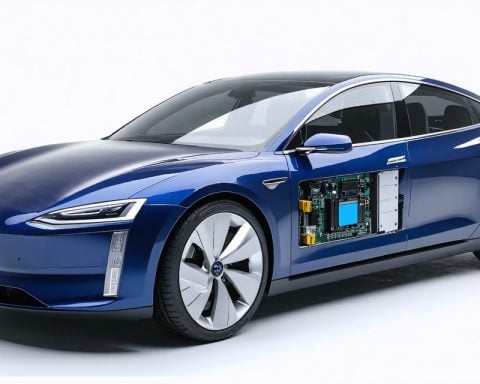- Tesla faces significant challenges in China, largely due to geopolitical issues rather than technological advancements.
- China’s regulatory hurdles delay the launch of Tesla’s Full Self-Driving (FSD) technology, potentially used as leverage in U.S.-China trade negotiations.
- Data security mandates complicate AI training data transfers between the U.S. and China, hindering Tesla’s development.
- Local competitors like BYD and XPeng are advancing rapidly, deploying Level 2 and Level 3 driving assist features, which attract consumer interest.
- Tesla’s past diplomatic relations and recent tariffs pose risks of escalating trade tensions that could impact its progress in China.
- Tesla must navigate political and regulatory issues to remain competitive in China’s dynamic electric vehicle market.
Tesla’s journey in China has hit a formidable speed bump—not from technology, but from the tangled web of geopolitics. While Elon Musk’s electric vehicle titan eagerly anticipated the launch of its Full Self-Driving (FSD) technology by 2025, Beijing’s stringent regulatory brakes remain firmly engaged, leaving Tesla in a state of uncertainty. The possibility looms that China may be using this approval as leverage in delicate trade negotiations with the United States. This geopolitical chess game places Tesla at a distinct disadvantage as Chinese EV competitors, such as BYD and XPeng, rapidly accelerate their own advancements in autonomous driving.
This regulatory maze doesn’t end with delayed software approvals. Tesla finds itself wedged between U.S. and Chinese directives on data security, preventing crucial AI training data transfers across borders. At the same time, local EV contenders outpace Tesla with swift deployment of Level 2 and even Level 3 driving assist features, capturing consumer interest with competitive offerings.
The crux of Tesla’s dilemma isn’t just technological; it’s political. Even Musk’s previously advantageous rapport with former President Donald Trump now casts a shadow. Recent tariffs could embroil Tesla in a potential trade skirmish, threatening any further headway in this crucial market.
As the electric vehicle landscape continues its rapid evolution, Tesla risks falling behind unless it can swiftly adapt to China’s political and regulatory currents. Without securing a foothold in this hypercompetitive arena, Tesla might find itself watching in the rearview as local champions seize both market share and the imagination of a nation transitioning to electric-powered dreams.
Is Tesla’s China Dream Stalling Amid Geopolitical Tensions?
Navigating the Geopolitical Maze: Tesla’s Challenges in China
Tesla’s ambitious plans to revolutionize the electric vehicle (EV) market with Full Self-Driving (FSD) technology in China have hit a regulatory and political wall. As the company grapples with geopolitical complexities, it risks losing ground to local competitors like BYD and XPeng, which are rapidly advancing their autonomous technologies.
How-To Steps & Life Hacks: Navigating Complex Markets
1. Local Partnerships: Form strategic alliances with domestic companies to better understand and navigate regulatory landscapes. These partnerships can also aid in localizing technology to meet market-specific needs.
2. Diversify Market Strategy: Avoid relying too heavily on a single market by expanding to other emerging EV markets like India, Europe, or South America.
3. Regulatory Engagement: Engage with local regulatory bodies early and often to ensure compliance and anticipate future regulations that could impact technology deployment.
Real-World Use Cases: Autonomous Vehicles in China
Chinese consumers are embracing autonomous driving features available in local vehicles, which are often ahead in the fast-paced technological race. Examples include:
– XPeng’s P5: Offering LiDAR technology and smart assist functions, the XPeng P5 is gaining popularity for city navigation.
– BYD’s Han EV: Equipped with advanced autonomous features, drawing consumers interested in cutting-edge technology.
Market Forecasts & Industry Trends: China’s EV Landscape
According to a report by McKinsey, China is projected to see exponential growth in the EV sector, with sales expected to reach 7 million by 2025. The report highlights the importance of local manufacturing and using locally sourced components to stay competitive.
Controversies & Limitations: Tesla’s Tightrope Walk
– Data Security Concerns: Chinese regulations on data transfer pose significant hurdles for Tesla, as the exchange of data between the U.S. and China is delicate and heavily scrutinized.
– Political Tensions: The ongoing trade tensions between the U.S. and China may serve as a roadblock, further complicating Tesla’s operations and market penetration.
Features, Specs & Pricing: Tesla vs. Chinese EVs
While Tesla’s models, such as the Model 3 and Model Y, are revered for their battery range and performance, Chinese competitors are offering models with comparable specs at competitive prices, sometimes including more advanced autonomous features.
Security & Sustainability: Ensuring the Future
– Environmentally Friendly Manufacturing: A move towards sustainable production practices is essential; local rivals are already adopting green technologies to attract environmentally conscious consumers.
– Cybersecurity Measures: With data privacy a significant concern, implementing advanced cybersecurity protocols is crucial to ensure user data protection.
Pros & Cons Overview
Pros of Tesla in China:
– Strong brand recognition and a fanbase.
– Superior technology in terms of battery performance.
Cons:
– Regulatory hurdles due to geopolitical tensions.
– Strong competition from rapidly advancing local brands.
Actionable Recommendations & Quick Tips
1. Evaluate Local Production: Intensify efforts to manufacture locally, reducing reliance on imports and potential tariff implications.
2. Adapt Technology: Develop tailored autonomous driving solutions that comply with local regulatory standards.
3. Enhance Brand Loyalty: Engage with the Chinese market through localized marketing and by contributing to local community initiatives.
4. Focus on After-Sales Service: Improve service infrastructure to create end-to-end customer satisfaction.
By understanding the intricate balance of technological advancement and geopolitical strategy, Tesla can adapt its approach to sustain and grow its share in the competitive Chinese EV market. Exploring diversified strategies and enhancing adaptability will be key to overcoming these challenges.













